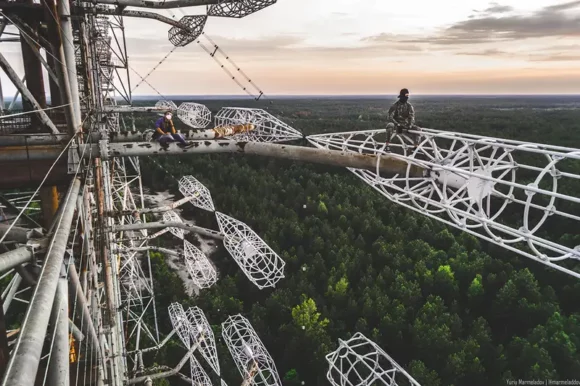Watching Iara Lee’s Stalking Chernobyl for New Scientist, 3 June 2020
The film festival circuit is frozen for lockdown, so how are independent filmmakers to ply their trade? Cultures of Resistance Films has released this gem to free streaming services. It deserves much more of a splash on its launch, but the times are what they are, and I for one am grateful. Stalking Chernobyl is a gripping and sensitive documentary about how, little by little, awkwardly, and not without controversy and conflict, ordinary people are reclaiming the site of the world’s worst nuclear accident.
In 1970, on the Ukraine-Belarus border, ground was broken for the Chernobyl nuclear complex and the neighbouring workers’ city of Pripyat. Chernobyl was constructed in a worrying rush but Pripyat was a labour of love, and loved by all who lived there, a comfortable, well designed, family-friendly city full of trees and roses, good public transport, a river to play in, excellent day care and schools, a cracking swimming pool… the list goes on.
On Saturday 26 April 1986, an uncontrolled chain reaction tore the roof of Chernobyl’s No. 4 reactor. Pripyat was evacuated and a thirty kilometre-radius exclusion zone was established while men fought — and died — to prevent further catastrophe.
The Zone is still in place, but it is possible to visit. I went more than four years ago, in the heart of winter. The guides showed us the main sites under snow, fed us in Chernobyl’s cavernous canteen, and led us through Pripyat, already half-swallowed by surrounding forest. It was lonely and cold. There were wolves.
Since then the number of visitors to the Exclusion Zone has doubled each year. That’s 40,000 people as clueless as I was, now traipsing about the place. The place’s character is changing.
There are problems and annoyances. Trespassers build fires at night with local wood, not realising how much radiation they’re releasing. Tourists are dressing up the sites to make better photos. The children’s dolls you find littering an abandoned school are dropped there by tourists. So are half the books.
Stalking Chernobyl’s great strength is that it doesn’t rush to judgement. Isn’t leaving a doll here a little like leaving a wreath? And since when was it wrong to want to explore — or unnatural for the young to want to court danger?
Old hands in the Zone complain about the cluelessness of the self-styled “stalkers” who sneak into the site. But everyone — even the mayor, whose job it is to keep the site secure — understands what brings them here. Meeting communities of trespassers, tourists and guides, we find them flowing into each other. A stalker wants to become a guide. An ex-guide says she’ll return as a tourist. We witness arguments, but no entrenched positions. The place doesn’t seem to allow it. Several interviewees say the zone is a special place — a place that will punish them if they mistreat it.
The film’s director Iara Lee, a veteran of difficult and challenging projects in the Middle East and beyond, writes: “I wanted to show [how] a film which is, on its surface, about adventure and exploration, brings forward deeper conversations… about the feasibility of nuclear power and the unintended consequences of pursuing high-tech solutions to our problems.”
By her own measure, the film fails. She doesn’t give herself nearly enough room to make a good anti-nuclear argument. To my mind, though, she’s made something more valuable, and certainly more unusual. She has shown how ordinary people — parkour enthusiasts and policemen, BASE jumpers and festival organisers — are showing love and care — each in their own way — to one of the saddest places on the planet. Stalking Chernobyl had me trusting, much more than usual, in the ability of ordinary people to make the best of their society’s most terrible mistakes.

